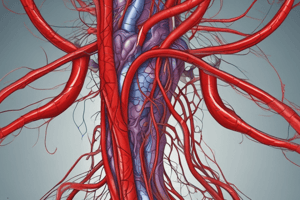Podcast
Questions and Answers
What type of blood vessel drains blood away from the heart?
What type of blood vessel drains blood away from the heart?
Artery
What type of blood vessel drains blood towards the heart?
What type of blood vessel drains blood towards the heart?
Vein
What is the hollow space within a blood vessel called?
What is the hollow space within a blood vessel called?
Lumen
What is the process by which contraction of smooth muscles in blood vessels decreases blood flow to the extremities or skin?
What is the process by which contraction of smooth muscles in blood vessels decreases blood flow to the extremities or skin?
What is the process by which smooth muscles in blood vessels relax, allowing for increased blood flow to the extremities or skin?
What is the process by which smooth muscles in blood vessels relax, allowing for increased blood flow to the extremities or skin?
What is a microscopic artery that serves as a transition between arteries and capillaries?
What is a microscopic artery that serves as a transition between arteries and capillaries?
What type of vessels are only one cell layer thick and allow for rapid exchange of gases and nutrients?
What type of vessels are only one cell layer thick and allow for rapid exchange of gases and nutrients?
What tiny veins connect veins and capillaries and help to drain blood back to the heart?
What tiny veins connect veins and capillaries and help to drain blood back to the heart?
What structure within a vein prevents backflow of blood on its return to the heart?
What structure within a vein prevents backflow of blood on its return to the heart?
What type of blood vessel allows the passage of gases and nutrients through its walls?
What type of blood vessel allows the passage of gases and nutrients through its walls?
Arteries always carry oxygenated blood away from the heart.
Arteries always carry oxygenated blood away from the heart.
Study Notes
Circulatory System Overview
- Comprises heart, blood vessels, and approximately five liters of blood.
- Transports oxygen, nutrients, hormones, and waste products throughout the body.
- Blood vessels enable quick and efficient blood flow from the heart to the body and back.
Types of Blood Vessels
- Arteries: Carry blood away from the heart; thicker walls to withstand high pressure; can be elastic (large arteries) or muscular (smaller arteries).
- Veins: Carry blood toward the heart; thinner walls and larger lumens; generally equipped with valves to prevent backflow due to low pressure.
- Capillaries: Smallest blood vessels; facilitate nutrient and gas exchange; walls consist of a single layer of endothelial cells.
Structural Characteristics
- Tunica Intima: Inner layer composed of endothelial cells and connective tissue; specialized simple squamous epithelium called endothelium.
- Tunica Media: Middle layer; thicker in arteries for blood pressure management; contains smooth muscle.
- Tunica Externa: Outer layer made of connective tissue, primarily collagenous fibers; provides structural support.
Arteries
- Conduct blood away from the heart; thick walls with high elastic fiber percentage, especially near the heart.
- Elastic arteries (>10 mm in diameter) include the aorta and pulmonary trunk, allowing expansion and recoil.
- Muscular arteries have a thicker tunica media, allowing precise control of blood flow distribution.
Arterioles
- Small vessels leading to capillaries; share structural characteristics with larger arteries but with reduced thickness.
Capillaries
- Microscopically small, enabling tissue perfusion; consist of an endothelial layer and basement membrane.
- Types include:
- Continuous Capillaries: Most common, tight junctions prevent leakage.
- Fenestrated Capillaries: Have pores for larger molecule permeability; found in the intestine and kidneys.
- Sinusoid Capillaries: Least common; have extensive gaps and facilitate high-capacity passage of cells and large molecules.
Venules
- Small veins (8–100 micrometers in diameter); link capillaries and veins; consist of endothelium, thin muscle layer, and connective tissue.
Veins
- Conduct blood toward the heart; larger lumens and thinner walls than arteries.
- Valves present to promote unidirectional blood flow and prevent backflow in low-pressure environments.
Comparison of Arteries and Veins
- Direction: Arteries = away from heart; Veins = toward heart.
- Appearance: Arteries = rounded; Veins = irregular, collapsed.
- Pressure: Arteries = high; Veins = low.
- Wall Thickness: Arteries = thick; Veins = thin.
- Oxygen Concentration: Higher in systemic arteries; lower in systemic veins.
Summary of Blood Flow
- Blood flows from arteries to arterioles, then to capillary beds for exchange, returning via venules and veins to the heart.
- Vasoconstriction and vasodilation influence blood flow significantly.
Key Questions Recap
- Arteries drain blood away from the heart.
- Veins drain blood towards the heart.
- The lumen is the hollow space within a blood vessel.
- Vasoconstriction decreases blood flow; vasodilation increases it.
- Arterioles transition between arteries and capillaries.
- Capillaries are one cell layer thick, allowing rapid exchange.
- Venules connect capillaries and veins, helping drain blood.
- Valves in veins prevent backflow toward the capillaries.
- Capillaries allow passage of gases and nutrients through their walls.
- Not all arteries carry oxygenated blood (pulmonary arteries carry deoxygenated blood).
Studying That Suits You
Use AI to generate personalized quizzes and flashcards to suit your learning preferences.
Related Documents
Description
Test your knowledge on the circulatory system in this quiz focused on blood vessels. You'll explore the five types of blood vessels and their structures. Perfect for students of Human Bioscience 1 at Tonga National University.




